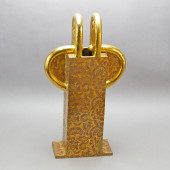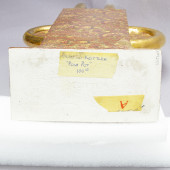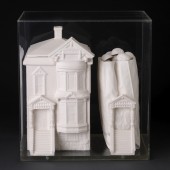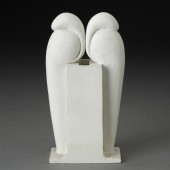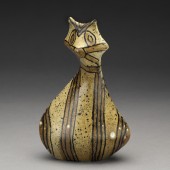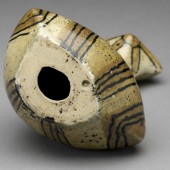![]() Printer version
Printer version
Howard Kottler
1930Born Cleveland, Ohio
1989Died Seattle, Washington
EDUCATION
1952BA Ohio State University, Columbus, Ohio
1956MA Ohio State University, Columbus, Ohio
1957MFA Cranbrook Academy of Art, Bloomfield Hills, Michigan
1964Ph.D. Ohio State University, Columbus, Ohio
PRIMARY WORK EXPERIENCE
1961-1964Instructor, Ohio State University, Columbus, Ohio
1964-1972Professor, University of Washington, Seattle, Washington
BIOGRAPHY
Howard Kottler is known as an innovator in his choice of subject matter and his use of commercially available porcelain blanks, ready-made molds, and decals. As a leader in the Seattle Funk movement, Kottler’s works in the early 1960s were hand-formed, organic sculptural shapes with rough surfaces made by the use of organic materials that were consumed during the firing process. Additionally, his extensive research with Egyptian paste further reinforced the hand of the artist by revealing the marks of the artist’s fingers and tools.
In the late 1960s and 1970s, Kottler became identified with the Pop Art movement as his work moved more toward questioning accepted standards as a vehicle for social commentary. The use of controversial subject matter for ceramic art was part of the shock effect of Pop Art’s rethinking of what was appropriate for an art object.
Having learned to use decals at the Arabia Factory in Finland (1957), he began using mass-produced porcelain blanks with commercial decals that he cut and altered for maximum effect. The use of these materials developed into a major body of work dealing with social and political as well as twisted art historical images. As an example of his decal work, his plate series, numbering more than 1000 variations, was radical on two fronts: Not only was the imagery confrontational, but also, was the unheard-of use of commercially-produced ceramics as a canvas for manufactured decals. Kottler used the juxtaposition of these products to highlight the moral and ethical conflicts inherent in the reality of the social and political issues of the day namely, Watergate and the Vietnam War. Unfortunately, his intent, in these works, was often misinterpreted as an affront to craftsmanship and the studio potter.
His Grant Wood Ware Set (1972) pokes fun at the concept of luxury, revered historical icons, and the presentation of valued objects. Factory-produced porcelain plate blanks with applied altered commercially-produced decals slipped into seemingly precious leatherette storage sleeves and sold in faux wooden presentation boxes. A perfect rejection of the symbols of luxury and presentation.
Other series were pots and vases that relied on imagery influenced by his love of the Art Deco movement, satirical presentations of objects trapped in the molds of their fabrication, and a series of self-portrait silhouettes using his infamous Fu Manchu mustache. Kottler’s ceramic art can be truly said to have set the stage for a new genre of in-your-face clay, a genre which is alive and well today.
The Marks Project would like to thank Judith Schwartz for contributing this essay, December 14, 2014.
PUBLIC COLLECTIONS
American Museum of Ceramic Art, Pomona, California
Art Institute of Zanesville, Zanesville, Ohio
Bellevue Art Museum, Bellevue, Washington
Butler Institute of American Art, Youngstown, Ohio
Cleveland Museum of Art, Cleveland, Ohio
C.M. Russell Museum, Great Falls, Montana
Cooper-Hewitt National Design Museum, Smithsonian Institution, New York, New York
Cranbrook Academy of Art Museum, Bloomfield Hills, Michigan
Dayton Art Institute, Dayton, Ohio
DePauw University Art Center, Greencastle, Indiana
Detroit Institute of Arts, Detroit, Michigan
Everson Museum of Art, Syracuse, New York
Hallie Ford Museum of Art, Willamette University, Salem, OR
Henry Art Gallery, University of Washington, Seattle, Washington
Kansas City Art Institute, Kansas City, Missouri
Los Angeles County Museum of Art (LAMCA), Los Angeles, California
Mills College Art Museum, Oakland, California
Museum of Fine Arts, Boston, Massachusetts
Museum of Arts and Design, New York, New York
Portland Museum of Art, Portland, Maine
Syracuse University Art Galleries, Syracuse, New York
BIBLIOGRAPHY
Adlin, Jane. Contemporary Ceramics: Selections from the Metropolitan Museum of Art. New York: Metropolitan Museum of Art, 1998.
Failing, Patricia. Howard Kottler: Face to Face. Seattle, WA: University of Washington Press, 1995.
Halper, Vicki. Look Alikes: The Decal Plates of Howard Kottler. Seattle, WA: Tacoma Art Museum, 2004.
Schwartz, Judith. "Howard Kottler: An Irresistibly Irreverent Iconoclast.” Ceramics: Art and Perception 22, (1995).
______________. Confrontational Ceramics. Philadelphia, PA: University of Pennsylvania Press, 2008.
CV or RESUME: Click Here to Download
Source: Elaine Levin Archive, University of Southern California
CV or RESUME: Click Here to Download
Source: Marcia Rodell Gallery, Elaine Levin Archive, University of Southern California
 | Center For Craft |
 | AMOCA American Museum of Ceramic Art |
Back stamp mark is a decal in platinum used only on Howard’s plates,… those store bought decal manipulated plates are from ’65-through 80’s. His last name Kottler was carved into wet clay and his other back stamp H with a K crossed over —both of these were used interchangeably on all other works 57- to death in 89. (Judith Schwartz 12/13/2016)
Method: Hand-Built
Dimensions: 9.1 x 14.7 x 11.2 inchesSurface Technique: Gilding
Materials: Stoneware
Method: Slab-Built, Hand-Built
Surface Technique: Glaze, Luster, Overglaze, Transfer or Decal Decorated
Method: Cast
Surface Technique: Overglaze (On Glaze), Transfer or Decal Decorated
Citation: Schwartz, Judith. "The Marks Project." Last modified June 17, 2025. http://www.themarksproject.org:443/marks/kottler






















